Catmint or Catnip for Cats and Bees: Growing, Harvesting, Using
There are 2 kinds of catmint, both from the mint family and often confused; catnip and catmint. They grow the same way, they are great spreaders that like full sun and regular watering.For the cat, there is only one type of mint and that is the mint called catnip - Nepeta Cataria, that grows 2 - 4 feet tall. This is the one that makes cats go crazy for. It has gray-green, downy leaves and either lavender or white flowers in spring.
This catnip is the perennial herb that is attractive to most cats and known as Pussy's Delight.
To confuse matters further, it is also known as Cataria, Catnep, Catrup, Cat's Heal All, Cat's-play, Cat's Wort, Catswort, Catwort, Chi Hsueh Tsao, Field Balm, Garden Nep, Herba Cataria, Herba Catti, Nebada, Nep.
Catnip and Cats
I have seen some cats going absolutely gaga over catnip and being very chilled out, others being very hyped up by it, and others still being very aggressive after their encounter and wanting to fight with all and sundry. However, this probably based on the type of interaction with the plant.
Cats that just sniff this type of mint are hyped up, those that actually eat the leaves are calmed by it as it acts as a sedative. For those cats that become aggressive you probably find that they have eaten some of the root as it is said that those that do, even humans, end up feeling aggressive and acting with aggression.
True Catmint
It is much more ornamental and your kitty will not go crazy over this type of mint like the first type. Also, deer don't seem to like this plant either. It is drought resistant once it gets established, and is perfect for zones 5-9. Finally, the butterflies love this type of catmint as do the bees, so ideal if you want to attract both to your garden, especially if you are into beekeeping.
Moses Quinby, the famous American beekeeper, is said to have stated that if he were to grow any plant intensively for the honey it produces that plant would be catnip. As a result the Nepeta faassenii plant or "Faassen's Catnip" is often planted in waste areas for this purpose.
Description of Catmint
Its erect, square, branching stems, from 18 to 36 inches tall, bear notched oval or heart-shaped leaves, whitish below, and during late summer terminal clusters of white flowers in small heads, far apart below, but crowded close above.The fruits are small, brown, oval, smooth and with three clearly definite angles. An ounce contains about 3,400 seeds. Viability lasts for five years.
Growing Catmint and Catnip
Before you grow your catnip you will need to make sure that your little plants are protected from your cats until they get established. If you don't they will roll on them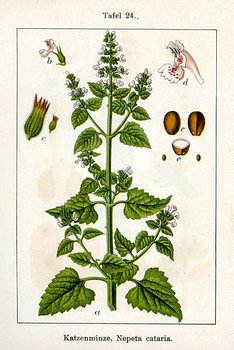 and damage
them before they can come to
anything.
and damage
them before they can come to
anything.Catnip of catmint can either be grown from seed, by cutting or by sub-dividing larger plants.
Catmint and catnip will grow with very little attention on any fairly dry soil, although will do just as well on fertile soil that is protected from cold winds. Although they prefer to be planted in full sun, they will also grow in partial shade. If you plant your catnip or catmint in sandy soil you will get a stronger flavor from the leaves than if you plant it in clay soils.
The herb seed is sown in autumn or spring once the soil has warmed up, either in situ or for subsequent transplanting. If the catnip is kept in a garden bed they should be planted 18 to 24 inches apart each way.
Nothing is needed except to keep down the weeds in order to have them succeed for several years on the same spot.
Harvesting Catmint and Catnip
Harvest your catmint or catnip when the mint is in full bloom. Cut the tops off the plants and tie bunches together and dry upside down high up and away from your pussy cat. You can also dry the mint in the oven. Remove the leaves, place on a single layer on a baking sheet and bake at 110° F until dry and crumbly. You can use these for stuffing little felt balls or mice for your cat to play with.Using Catmint
As a condiment the leaves can be used in sauces; but the taste can be a bit strong. Still, the French use catnip to a considerable extent.The plant has been consumed as a tea, juice, tincture, infusion or poultice, and has also been smoked. Catmint oil is also good for getting rid of cockroaches, flies and mosquitoes.
If you plant catmint in your borders and among your vegetables for companion planting it will deter flea beetles. When inter planted with potatoes and capsicums catnip also reduces aphids in your veggie patch.
Catmint leaves in herbal tea recipes, either fresh or dried, is an excellent remedy for menstrual problems, however, if you are pregnant avoid taking catmint.
If you would like to advertise your farm in Europe for free because you need some help on the farm to pick those crops, or whatever, see our section on farming jobs worldwide. Or, if you want to advertise your farm produce, farm accommodation or a farm service look at our section Advertise your Farm. Please feel free to contact us for any further inquiries.
Did you find this page helpful?
Sharing is a way of saying, "Thanks!"
Follow Us and Keep Up to Date
Leave a Comment or a Picture of ways in which you Use Catmint
Do you have anything that you would like to add after reading this page? We would love to hear your thoughts. If you can add additional information to what has been written here you will be adding value to the website! No need to have any special skills - just type and submit. We will do the rest!
Leave a Comment
Do you have anything that you would like to add after reading this page? We would love to hear your thoughts. If you can add additional information to what has been written here you will be adding value to the website! No need to have any special skills - just type and submit. We will do the rest!




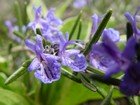
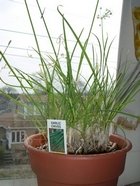
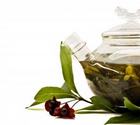
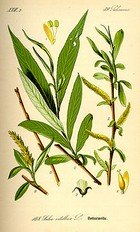
New! Comments
Do you have something of value to add? Leave me a comment in the box below.